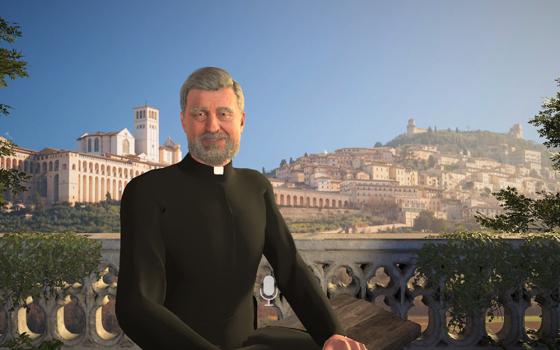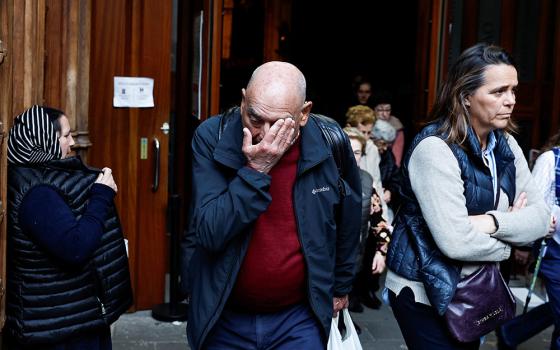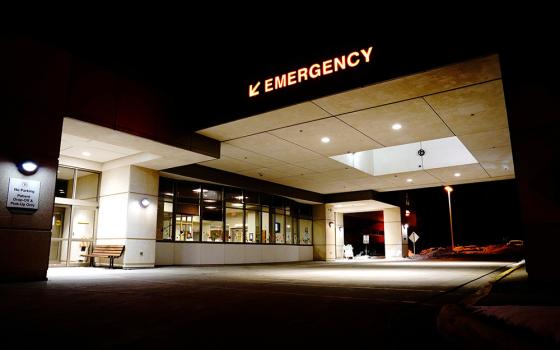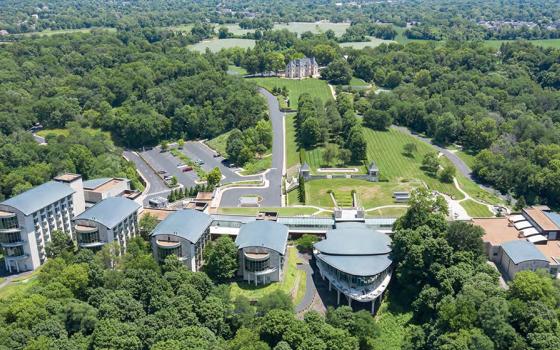We continue our week long conversation with Rocco Palmo, the blogmeister at Whispers in the Loggia.
The question: What is the most important thing that will happen at the USCCB meeting in November?
Rocco Palmo: One of the perks of covering church politics is that, while the country has to wait four years between presidential elections, American Catholics get one every three. So yet again, this year’s “Fall Classic” -- the USCCB’s November Meeting in Baltimore -- will see the Making of the President, Church Edition.
That said, the top-ballot’s outcome is the least suspenseful part of the process. Following a custom that’s essentially been inviolate for the half-century since the US bishops began electing a president, barring anything apocalyptic the incumbent vice-president of the body, 69 year-old Bishop Gerald Kicanas of Tucson, will be elevated to the top slot. As ever, the real race is the one that’ll determine his #2... and this time, a very changed scene since 2007 renders who makes the cut even more intriguing than usual.
The process is already underway. Through the summer, the bishops are asked to nominate . From their result, the conference staff crunch a list of the ten most-cited prelates, and that sets the slate. Come the plenary’s Monday morning start, the vote takes place; the 300-odd active bishops elect the president, with the remaining nine names forming the first ballot for VP. If no candidate attains a majority on the first shot, the two biggest vote-getters then face off against each other, and once the winner’s chosen, the next three -- and, given the deputy’s traditional ascent, six -- years are set.
Granted, for some out there, all this might have the ring of “deck-chairs.” Where that’s the case, though, be wise to remember three words: Health. Care. Reform. The fight over the Congressional Democrats’ now-enacted package sparked the most high-profile episcopal policy push (and, in response, internal tussle) the national church has seen in years, if not decades. But considering that last year’s Five-Ring Circus in Baltimore opened as, among others, no less than Politico featured top-story analyses of how the bishops would move -- and how the body’s concerns produced a significant impact on the debate’s evolution from there, all the way to the final product -- the lesson of the process remains that, like it or not, total victory or not, rumors of the bench’s demise as a policy force remain exceptionally unfounded.
While the highlights -- and not-so-highlights -- of the reform fight (and, more broadly, the bishops’ national response to the Obama administration and politics altogether) will arguably loom over the VP ballot more than any other issue, let’s leave even that aside. The tea-leaves always run rich in the bench’s top elections, and even more than one or another question of what moves civilly, the slate tends to forecast the future not just for the conference’s leadership within itself, but who ends up being seen as speaking for, and leading forward, the nation’s largest religious body all told. And that’s when they don’t win.
Above all else, we’ll have to see if two pronounced recent trends hold up.
First, just like our friends Up North -- the Canadian bench, which invariably alternates its presidency between Francophone and Anglophone prelates -- the last three Stateside cycles have seen the bishops strike an unprecedented balance between the conference’s “orthodox” and “progressive” factions.
In 2004, the VP race came down to the then-bishop of Pittsburgh, Donald Wuerl, and the now-departing chief, Chicago’s Cardinal Francis George. Despite the conference’s longstanding aversion to electing a red hat to one of its top posts, George won by a razor-thin margin of 118-112 (percentage-wise, literally 51-49), becoming the first prince of the church ever placed in line to lead the Stateside bench.
Three years later, the dynamic played replayed itself, just with the result flipped. In the runoff, Rome’s most cherished American alum, Archbishop Timothy Dolan, then in Milwaukee -- faced Kicanas, the efficient, wonkish, strict vegan protege of the conference’s revered architect, Cardinal Joseph Bernardin. Though the ever-exuberant Dolan walked onto the Floor before the vote surrounded by a horde that memorably resembled a champion entering the ring, a difference of 22 votes (128-106; 55-45%) handed Kicanas the #2 slot.
That said, as consolation prizes go, losing the vice-presidency might just bring the best one of any contest anywhere. In each of the last four head-to-heads for the post, the victor went on to six years of meetings, morning calls and paperwork. In far quicker order, however, the vanquished was named to a cardinalatial see -- St Louis’ Archbishop Justin Rigali was given Philadelphia less than two years of losing his second-straight final ballot in 2001; Wuerl was promoted to Washington all of six months after being bested by George and, of course, Dolan took New York 15 months after coming up short among the brethren.
Bottom line: the presidency might last three years... but, lest anyone forgot, a red hat is forever. (And being a son of the next cardinalatial church to transition on these shores, the electors are asked to be especially merciful this time around.)
That’s not the only portending of the future the slate carries -- since the 2007 election, all but one of the eligible seven nominees who didn’t make the final VP vote has likewise landed in an archdiocese: the omni-competent Dennis Schnurr (a former general secretary of the conference and lead overseer of its 2007 downsizing) succeeded two past presidents as archbishop of Cincinnati; then in Oakland (and fresh from dedicating its $190 million “Space Egg” cathedral), Allen Vigneron was sent home to Detroit, becoming the beleaguered Motor City church’s first native-son archbishop just as, in Katrina’s wake, the then-bishop of Austin, Gregory Aymond -- one of the few “barometer bishops” on today’s scene, able to find the body’s center and hash out a consensus among both sides -- returned to New Orleans as the first-ever homegrown head of its 220 year-old local church. (In a keen side-note, Vigneron and Aymond faced off last year for the chair of the Bishops’ Committee for Divine Worship -- the prelate who’ll be tasked with the final push toward November 2011’s implementation of the new Roman Missal. In yet another close vote, the latter won, 126-110.)
While the standing of all three is arguably burnished by their appointments to metropolitan churches -- and, indeed, each cuts the figure of a future president -- time will tell if the bench deems the trio too early in their new assignments to take on the conference’s most time-consuming responsibilities. Adding to this, the downturn’s unparalleled impact on the Motor City’s economy and the Crescent City’s continuing challenges of post-storm rebuilding mean that, in ways they didn’t last time, two of the three already have their hands a bit fuller at home.
What’s more still, with Dolan now on Madison Avenue -- and as a result, now subject to the conference’s ingrained paranoia about investing electoral prominence in the head of an already high-profile archdiocese -- the odds of an encore would appear slimmer than if had he remained in Milwaukee, but balancing the globe-trotting chairmanship of Catholic Relief Services with the 2.5 million-member Gotham church doesn’t allow one much time to complain. And lastly, the two highly-regarded elder statesmen who appeared on the 2007 ballot -- Rigali and Erie’s Bishop Donald Trautman -- are now either past or soon to reach their 75th birthdays, so they’ve effectively been “aged out” of contention.
In a nutshell, that leaves two prelates from the last slate who: 1. haven’t been moved since the last go-round, and 2. are sufficiently young to serve a six-year mandate. And keeping with the trend of recent cycles, both fall toward the body’s conservative side: Bishop William Lori of Bridgeport, 59, the influential Supreme Chaplain of the Knights of Columbus, whose oversight of the Doctrine Committee during the 2008 elections saw him take the conference’s lead in chastising Nancy Pelosi after the House Speaker’s infamous Meet the Press comments on when human life begins, and the leader of the bishops’ intense push for the defense of marriage -- Louisville’s Archbishop Joseph Kurtz, 64, a social worker by training and the departing conference treasurer.
Counting the president-in-waiting, however, the perfect storm of changed circumstances since the last election could see the slate carry over as many as seven open slots in which the body will present a snapshot of the qualities it desires in leadership. And in who makes the cut this time, smart money would expect at least some surprises.
To wrap, given the aforementioned intensity of criticism the Mothership has taken over recent years, all this raises an interesting corollary: among the bishops he’s inherited, the overwhelming bulk of Benedict XVI’s choices for upward movement (among others, Dolan, Vigneron, Aymond, Kurtz, Sacramento’s Soto, Salt Lake’s Wester, St Louis’ Carlson, Boston’s O’Malley, LA’s Gomez and Miami’s Wenski all come quickly to mind) have extensive histories as “conference men” -- that is, figures who invest significant time in committee work, stand for (and win) elections for the body’s top posts and, essentially, won’t be caught carrying dynamite into 4th Street (read: USCCB Headquarters) anytime soon. Lone rangers might command the effusive admiration of a certain number of the faithful -- and, indeed, the bishops themselves. As for higher responsibility and visibility in ecclesial life, however, they’ve largely tended to stay put.
Lastly, though, a word on the bench’s departing head, and the legacy he leaves behind.
Over the years of his presidency -- and even as he prepared to take it up -- it’s been a cherished custom of mine that, whenever Francis George would make the news, the posts would be topped by a shot of the Chicago prelate, baton in hand, leading the Mormon Tabernacle Choir at a festival some months before his election.
By necessity, come November 15th, that shot will see its retirement. And, admittedly, I’ll miss it very much.
He hasn’t always been the most high-profile of the 14 prelates elected over time to lead this vast, fractious “flock of shepherds,” but the genius of George’s chiefship has been exactly that -- for whatever polarization we might see and hear about within the body of bishops, he hasn’t just been the president, but The Chief: the unquestioned, universally-respected leader of the pack, in a moment when no other figure could equal the stature and good humor, diplomatic skill and sharpness of mind he’s brought to the presidency... and, above all, to employ this exceptional mix to its greatest possible effect.
Whether they’re Right or Left, regardless of the dispute of the day, time and again the bishops have emerged from the executive sessions that have now become a standard feature of every plenary as pleased as stunned that the seeming irreconcilable was suddenly, almost miraculously, forged into a workable consensus. And over and over, from FOCA to health-care reform, Missal madness to a mission-minded push toward enhanced bonds of unity with church institutions, the same assessment of the president’s ability to bridge the divide would come from all sides....
“Masterful.”
And given the turbulent times and internal strains the bench has seen these last three years, even that is a seeming understatement.
Custom might limit the president to a single term. Still, you can bet that, as they prepare to pick a new Top Two in the American hierarchy’s birthplace, a healthy chunk of the electorate instead find themselves wishing for “three more years.”
Alas, as it always does, time -- and the church -- march on. And as a new president steps into the chair of an ever taller, more thankless task, God grant him his predecessor’s success.




